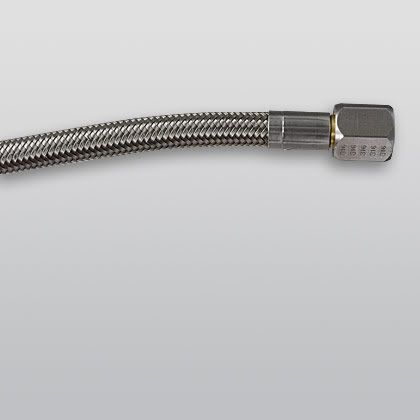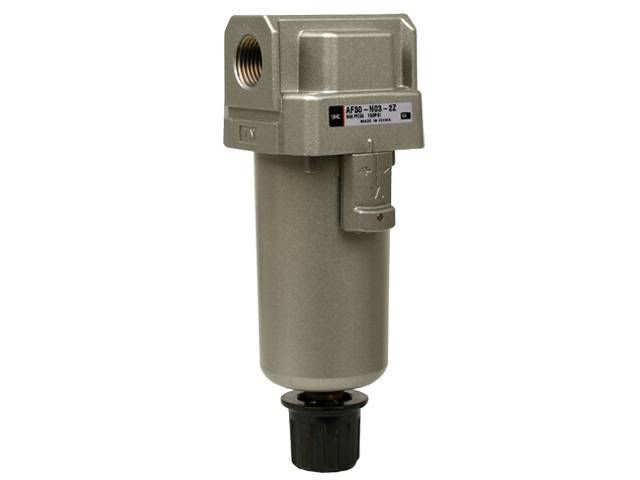(N.B. when I use the word "response" here, I mean the time it takes to raise the car and lower the car)
Length of air lines
The shorter the air line, the faster the response. That said, in a hatchback, the air lines can't really get too long anyway. Also, equal length air lines should be run, at least for the front pair and rear pair. This is to allow the volume of air being pumped into the air bags to be constant, meaning the same amount of air will be in the 'bags, in turn meaning an equal ride height. Now the tricky thing here is that not each corner of the car has the same weight bearing down on it. The amount of weight bearing down on the corner will proportionally affect the height the corner will sit at. Simply put, if all air lines are equal length and all corners are running the same type of airbag, then the corner that has the most weight will run a lower ride height if pumped up to the same PSI all around (this is why pressure-based auto-levelling digital systems aren't very reliable - I'll be writing an article on management systems soon).
Inner diameter (or ID)
The larger the ID, the faster the response. A 1/2" air line will raise and lower a car much much faster than a 1/4" air line. For the weight of a hatchback, a 3/8" air line is perfect - still quite fast, but not unsettling-fast as with a 1/4" air line. However, it's not as simple as just buying the largest air line hoping for the fastest response. There are other components in the system that will affect the response. Any fitting from the tank, to the valves and to the air struts play a role too. For example, in the air strut article, BagYard and Airlift's air struts have an air inlet fitting of 1/4" or 3/8". Fitting a 1/2" air line here will not result in a faster response as the fitting there is restricting air flow. Accuair's VU4 valve block is also restricted to 1/4". Some users equipped with large air lines that prefer a slower response often use reducers. These are simply fittings that reduce the ID at certain locations (whether it be at the air strut, valve block etc).
Air line material
First of all, every air line used must be DOT/ADR/TUV approved to ensure safety of use in a car. It's tempting to want to cheap out and buy the most cost-effective setup, but no one wants to be caught by a breakage in the air lines and have their car drag on the highway traveling at 110km/h.
The types of air lines used are generally separated into two categories, "soft" lines (like plastic polymer tubing) and "hard" lines (like copper pipes).
Plastic polymer tubing
Generally the most popular and easiest to manage/route. All off-the-shelf kits come with plastic polymer tubing. I've heard of PVC and nylon being used, but I'm having trouble finding out as to what exactly they're made of. Obviously they are made of many different layers to enable them to withstand high pressures.
They are quite resistant to anything thrown at it while mounted in/out of the car, though I have read some troubles with temperatures below zero. It is the easiest to setup as I believe it's just a matter of making straight cuts to the hoses and adapting it to the correctly sized fittings. I'll include a write-up of how to do that once I know what's involved.
Braided lines
These hoses are often teflon- or synthetic rubber-based cores wrapped in braided stainless steel (SS). The teflon (polytetrafluoroethylene, or PTFE) core is the recommended braided line to be used in airride applications due to constant high pressures and temperatures (if mounted close to the exhaust for example). Delikon rates their PTFE-core SS braided lines to withstand a max pressure of 3000 PSI. Their more economical SS braided lines (using a single-layer build) are rated at a max pressure of 250 PSI. Working pressure is not stated though. Working temperature range is between -73 to 260 degrees Celsius.
Leader lines (compress to tank) are usually SS braided lines. Besides that though, I don't see them used in airride applications much. I believe the reason is in the cost, as getting proper PTFE-core SS braided lines are quite expensive (and they require perfect cuts and proper crimping of fittings which the home DIY-er may not be capable of). There are many braided lines out there that are cheap but most likely will not do the job. Their popularity by tuners using it in applications such as in boost, fuel, nitrous and oil lines have spawned many cheap copies sold that may look the part but not actually able to withstand high pressures/temperatures. I had a set of braided lines that came with an oil catch can and after a few months of use, I can feel the oil vapours seeping through and condensing on the braids.
I think that proper PTFE-core SS braided lines would be a fantastic alternative to plastic polymer tubing as they're more durable (Delikon rates their lines to have a "limitless lifetime") and they look great. They're also flexible, meaning they maintain the benefits of a hard line system (read on below) but have the same (limited) maneuverability as plastic polymer tubing.
Metal piping
Hard lines. The pièce de résistance of any airride setup. These are also used in brake lines running along the chassis of a car. Different metals can be used but the most popular are aluminium, copper, mild (galvanised I assume) steel and stainless steel. Aluminium and copper are more malleable (easier to bend) than steel lines but because of their relative softness, may be more prone to breakage/splits. I think breakages occur due to unsatisfactory operating conditions (e.g. in a sub-zero snowy winter climate with salts on the roads) and improper fitting, and not due to inherent flaws of using aluminium/copper over steel. Stainless steel is generally more expensive compared to copper.
Pressure ratings are based largely on wall thickness but the tensile strength of the material and outer diameter also plays a role too; according to the Barlow formula:
Now I may have gone off on a tangent but I'm just wondering if this would effect air lines the same way? I'm assuming the main issue when it comes to choosing between the three would be durability (hard line > braided > plastic), cost (plastic > hard line > braided) and ease of preparation/installation (plastic > braided and hard line). Obviously there are no pedals when it comes to operating air suspension systems, but the response rates between the different hoses wouldn't be as simple as stating one's better than the other (i.e. many factors to consider that I'm not educated in yet).
In Australian climate (Sydney), I doubt there'll be a problem running any of the mentioned lines, so durability isn't a problem (as long as the lines are tested to be suitable for use as air lines and are DOT/ADR-approved). Plastic would be the absolute easiest to set up and route, as they're the most flexible and most systems are built with plastic tubing in mind. Braided lines will require a dedicated crimper (most likely taken to an expert) to fit on the appropriate fittings, and depending on what is used, adapters will be required. Hard lines require a decent bender and flaring tool, but once the investment is made on the tools, it won't end up being much more expensive than plastic tubing.
Then there's the contention of looks and practicality. Hard lines can be made to look very very pretty when the lines are polished up, are dead straight and the bends are spot on. Only problem is, I'm aiming to have a functional hatch to use too, and I carry a lot of wheels that may move around and I wouldn't want them hitting the hard lines and scratching them up. SS braided lines can look brilliant too.
Fittings
Most fittings used for airride in VAG circles are either NPT (National Pipe Thread; imperial measure) or PTC (Push-To-Connect).
Using brass NPT fittings will require teflon tape or a type of sealant to ensure no leaks are possible through the thread fittings. Some people have had trouble using tape, but a lot of installers are making the switch to Loctite 545 or 577 with perfect no-leak results (545 is more fluid than 577; 577 has a gel-like consistency, which may make it hard to spread over a very fine threads).
Those using braided lines have converted their fittings to use -AN fittings. Use of appropriate adapters/converters are all that's regarded, and measures must be taken to ensure leaks won't occur.
Restrictions in air flow
Besides having smaller fittings and fitting reducers, there are other ways to restrict air flow (whether it's desired or not). 90 degree fittings can affect air flow. They are often fitted to introduce bends when it comes to install air lines (convenience) but users often don't realise they are introducing an air flow restriction in their system. Compressed air travels at a very fast speed from high to low pressure - think of an F1 car travelling at 300km/h trying to tackle a hairpin. It's not gonna happen, so it's gotta slow down.
Unwanted kinks in the system from trying to wrap air lines around a tight corner will also impede air flow, and in severe cases, completely block the air from traveling.
Water traps
These are installed in the path of the air lines between certain parts of the air system to ensure as little condensed water will flow through the system. Common sections to place water traps would be between the compressor and tank, and between the tank and valves. Most builds I've seen have placed the water traps between the compressor and tank, but some have found that a lot of the moisture is still in the air after the water trap, and most of it is condensed in the tank which then migrates on to the valves and airbags. The best location to place them is in between the tank and valves. Any water that isn't trapped here would most likely have settled within the tank, which can easily be drained out.
Some have placed water traps in both positions, which makes for better protection against moisture in the air system. I'd probably do the same.
My plans
My plan for my boot install was to have it as stealth as possible while still retaining a good look. I wouldn't mind having the tank peep past the false floor; either way, I wouldn't have any of the lines showing at all. I would like to route the air lines underneath the car. My idea was to use braided on the inside and hard lines on the outside with braided leading up to the air bags (much like a brake setup). I would preferably like to set the boot up so I can lift the false floor and still have a show-worthy air-setup, but for daily driving I'd like it all covered up for noise dampening and also practicality (just storing shit).
Links:
http://www.airsociety.net/forums/showthread.php/350-Running-air-lines
http://www.delikon.com/teflon.html
http://www.minitruckinweb.com/tech/suspension/0303mt_stainless_steel_air_lines/index.html
http://www.airsociety.net/forums/showthread.php/120-Hard-Lines-vs.-Soft-Lines
http://www.airsociety.net/forums/showthread.php/648-can-AN-plumbing-be-used-for-air-lines
http://www.airsociety.net/forums/showthread.php/499-Loctite-545-on-fittings.
http://www.airsociety.net/forums/showthread.php/186-Water-Traps-question






No comments:
Post a Comment